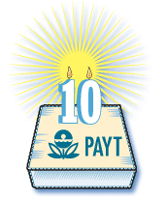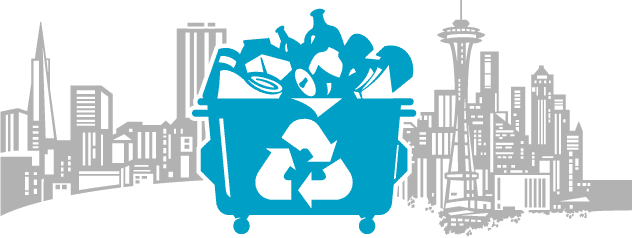PAYT Bulletin: Fall 2003
The PAYT Bulletin is designed to help solid waste planners and others get the latest pay-as-you-throw news and events. Use the links below to read articles from the Fall 2003 issue—our last issue available in print. Check back in Spring 2004 to read our newly designed online-only Bulletin.
![]()
Other Issues
- EPA and PAYT Celebrate Years of Growth and Success
- Could PAYT Offer Hope For New York City's Recycling Program? (Winter 2003)
- PAYT Helps Cities
Protect Climate
(Summer 2002) - Large Cities and
PAYT
(Winter 2002) - Bigger, Older, Wiser:
(Summer 2001) - Maine Turns
to PAYT
(Spring 2001) - State and City
Profiles
(Summer 2000) - PAYT From Sea
to Shining Sea
(Winter 2000) - PAYT Bulletin Archives
- EPA and PAYT Celebrate Years of Growth and Success
- Online PAYT Materials-Plentiful and Practical!
- PAYT Picks Up Abroad
- Massachusetts Adds Newest PAYT Program
- Pay-As-You-Throw Goes ONLINE

EPA and PAYT Celebrate 10 Years of Growth and Success
The origins of pay-as-you-throw (PAYT) programs stretch back to the 1920s, a fact that may make a mere 10-year PAYT anniversary seem almost insignificant. Yet, in the 10 years that have lapsed since 1993—the first year of EPA’s involvement with PAYT—the popularity of rate-based systems for waste disposal has grown at the highest rate in its nearly 80-year history, and shows no signs of slowing down. Now, EPA’s PAYT program is celebrating 10 years of increasing success. Since the beginning of EPA’s involvement, PAYT has expanded rapidly —from 1,800 communities in 1980 to more than 6,000 today, with more and more communities adopting PAYT every year.
In 1993, EPA acted on a vision to expand on the efforts of progressive communities throughout the country that had implemented rate-based models for waste disposal to encourage source reduction and increase recycling rates. Since then, in an effort to serve, inform, and encourage communities considering PAYT programs, EPA has provided an ever-increasing menu of resources, information, workshops, and technical assistance that has expanded PAYT’s profile both nationally and internationally, and guided numerous communities to PAYT success.
With a decade of experience and results under its belt, EPA’s
PAYT initiative is ready for the challenges of the next 10 years.
Foremost among these challenges is the implementation of PAYT in
America’s big cities.
Urban centers face several unique challenges compared to small-
and medium-sized communities. Large cities feature a higher proportion
of high-volume, multi-family housing with collective waste disposal
systems, rendering it difficult to determine the amount of waste
each household disposes of, a critical data point in PAYT implementation.
Additionally, the health hazards posed by not collecting trash due
to nonpayment in a high population density area tend to be a significant
deterrent, as does the fear of illegal dumping.
| City | Population | Year Introduced |
| Los Angeles, CA | 3,694,820 | 1996 |
| San Jose, CA | 894,943 | 1993 |
| San Francisco, CA | 776,773 | 1980s |
| Seattle, WA | 563,374 | 1981 |
| Austin, TX | 656,562 | 1997 |
| Portland, OR | 529,121 | 1992 |
| Oklahoma City, OK | 506,132 | 1997 |
| Albuquerque, NM | 448,607 | 1995 |
| Oakland, CA | 399,484 | 1985 |
| Sacramento, CA | 371,854 | 1999 |
In fact, as PAYT has proven successful, both environmentally and financially, in cities of all sizes, more and more large cities are working vigorously to institute PAYT programs. Indeed, large cities now have a variety of PAYT role models to follow around the country.
With communities such as these showing that PAYT is viable in larger cities, PAYT is beginning to be viewed more as a solution to problems, rather than a solution with problems. In New York City, PAYT is being presented as a solution to the growing threat to the city’s ambitious recycling program, which has already faced drastic service cutbacks as a result of the city’s budget crisis.
The increasing success of PAYT within larger urban areas is also creating a new market for PAYT programs overseas. Nearly 80 percent of Europe’s population is concentrated in its cities, putting a premium on innovative waste reduction solutions, and PAYT has emerged as a leading solution. The increasing consolidation of the European Union (EU), which has placed an emphasis on social, economic, and technological progress, has led many EU countries, including Germany, Austria, Sweden, and the Netherlands, to begin implementation of PAYT programs, while others are working aggressively to develop their own programs. Remarkably, despite disparate languages and cultures, many of these countries have continued to rely on EPA’s PAYT materials for assistance in the development and implementation of their programs.
As PAYT expands globally, it is also increasingly being recognized as a potential remedy to a global issue broader in scope than municipal waste disposal—climate change. Increasingly, municipalities are taking note that the initial objectives of PAYT—increasing recycling and source reduction—can also help to achieve compliance with the increasing number of national, state, and municipal greenhouse gas reduction goals. Although their primary goal is to increase recycling and encourage waste prevention, PAYT programs also help to reduce the greenhouse gases that are generated through the manufacture, distribution, use, and disposal of consumer products.
With PAYT’s gathering momentum among large cities both nationally and internationally, and the increased role that PAYT may play in reducing global climate change, EPA’s easy-to-use, self-directed PAYT tools stand ready to support the next 10 years of PAYT growth.

Online PAYT Materials—Plentiful and Practical!
From Indonesia to Argentina, countries all over the world are beginning to experiment with various forms of PAYT and are utilizing the valuable and easy-to-follow resources offered by EPA. And how are they obtaining PAYT information? Online, of course! That’s why EPA has decided to focus on making all PAYT materials available in an online-only format, including the PAYT Bulletin, beginning in 2004. Hard copies of select tools and resources are still available free of charge for interested parties, however EPA will transition its material ordering process from its telephone hotline to the Web site. This comprehensive online transition will save energy, trees, and money, and make PAYT materials more accessible.
 A Wealth of Resources
A Wealth of Resources
The vast array of online PAYT materials is designed to help guide municipalities through every step of a PAYT program—planning, implementing, enforcing, and evaluating. Whether your community is just beginning to consider a PAYT program for its solid waste management strategy, or needs guidance related to a specific issue of a well established PAYT program, EPA’s easy-to-follow online materials provide you with the answers you need.
The PAYT Web site offers a variety of self-directed PAYT tools for communities of any size, including:
- Case studies
- Community contacts
- FAQs
- Handbooks
- Newspaper and magazine articles
- Notices of events
- Related links
- Videos
- Workbooks
PAYT Picks Up Abroad
In 2002, 11 different countries including Australia, China, Colombia, India, Philippines, and Spain, as well as 112 U.S. cities in 36 states, placed orders for a total of 2,889 PAYT informational products. You too can order PAYT materials for assistance with your community’s solid waste management program! Fill out the online form here.
PAYT’s Proven Success
The valuable information included in EPA’s PAYT materials have allowed thousands of U.S. communities to recognize the wide ranging benefits of implementing PAYT programs. San Jose, California—the nation’s 11th largest city with 925,000 residents—more than doubled its recyclables and yard trimmings collected with its Recycle Plus Program. The program’s success is reflected in a 90 percent satisfaction rate among the city’s residents. Mount Vernon, Iowa—one of the smallest cities to implement a PAYT program with 3,700 residents—decreased its trash and yard waste collection by more than 50 percent, exceeding the waste reduction goal established by the state legislature. Mount Vernon’s program also produced a total savings in collection fees of $46,000 for the city’s 980 households. The inherent environmental, economic, and social equity benefits associated with variable rate pricing make PAYT programs a logical and successful approach to addressing the numerous challenges of solid waste management.
Staying Connected, Staying Informed
In association with PAYT’s online transition, it is important that you stay connected to EPA’s PAYT support network. To ensure that you continue to receive the online version of the PAYT Bulletin and updates on new PAYT tools and resources, please send an email to payt@icfi.com with your name, affiliation, mailing address, and email address. We will be sure to include you in our electronic address book. You’ve come this far—don’t get left behind!
Massachusetts Adds Newest PAYT Program
The Commonwealth of Massachusetts boosted its already impressive
total of 102 PAYT programs to 103 on July 1, 2003, when the town
of Natick (population 30,000), implemented its program. Natick,
located 18 miles southwest of Boston, chose to use 30-gallon blue
bags, which are sold through local grocery stores.
While PAYT programs have become commonplace in the Bay State, Natick’s
conversion to PAYT has not been a smooth or uncontested one. According
to the Boston Globe, the statewide group Mass Reform has mounted
stiff opposition, fearing that the program is not financially beneficial
and that the plan is likely to increase illegal dumping.
Should Natick have to defend its fledgling program, the town can find ample evidence of PAYT effectiveness in neighboring towns. Thirty miles south, Brockton, Massachusetts saved $2 million in waste disposal costs during its first year in 2001. Nearby Northborough, which launched its program in January, estimates a cost savings of $810,000 this year and has already increased its recycling rate from 19 percent to 34 percent, largely due to the kind of citizen support and understanding that Natick also hopes to generate.
“In general, the residents have supported this,” Northborough town engineer Fred Litchfield told the Globe. “They have more control over how much they pay for trash. If you use five bags, you pay for five bags. If you recycle more and can fit your trash into four bags, you save money.”
Want to see your PAYT program featured in the PAYT Bulletin? Send us your story! E-mail us at payt@icfi.com, and see your name in lights.
 |
Pay-As-You-Throw Goes ONLINE
To save trees, energy, and money, the PAYT Bulletin will be published ONLINE only, beginning in 2004.
If you would like to continue receiving the Bulletin in its online format, please send an email to payt@icfi.com with your name, affiliation, address, and email address. We will include you in our electronic address book.
![[logo] US EPA](../gif/logo_epaseal.gif)